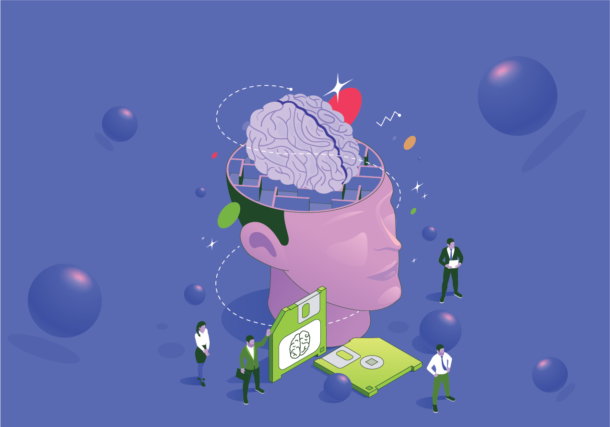The Constructivist Ideology of Neural Networks in Deep Learning
Neural or Neurons are something that we all have studied during our academic phase. The elementary structure of neurons consists of dendrite, axon, node of ranvier, myelin sheath, and axon terminals. But are you wondering why we are discussing neurons when the topic circles around neural networks in deep learning? Because it is vital to understand how a neuron structure is to know about how an artificial neuron works. Now imagine a picture of a neuron, A dendrite is considered to be input to a neuron, that entirely receives information from various other neurons, the second is the cell body, information processing happens in this region it takes all the information coming from the other dendrites and process the information completely. The last is the axon, it connects the dendrite hairs on the next one.

Moving now forward in understanding deep learning in neural networks is a model or machine learning program that makes a proper decision similar to what the human brain often makes! Besides, the neural network consists of several layers of nodes, artificial neurons, hidden layers, and output layers. Every single node connects and has its own weight and threshold powers. Want to learn more about how neural networks work and curious about the future of neural networks? Seek no more, when you are in the right place where you will get to know and understand the world of neural networks. Within this piece of blog, we have discussed the basic architecture of neural networks followed by how it works. Moreover, we will also be dealing with the application of neural networks along with its future, because of course every human being is curious about the future! So without any further dilly-dally let’s understand more about this topic!
Launching the Additional Insights about Neural Network in Deep Learning and its Architecture
Neural Networks in Deep learning are one of the components of the deep learning model. It generally consists of a combination of several layers where every layer comprises 3 main categories as we have seen above, input layer, hidden layer, and output layer. Neural Network is also considered to be an artificial neural network in deep learning. Now let’s move forward to understand the architecture of neural networks. The input layer is the primary structure where the data is fed into the network. Each neuron in this layer represents a feature of the input data. Hidden Layer is another component that lies in between the input and output layers where most of the computation occurs.

Each layer consists of multiple neurons, and these neurons are connected to neurons in the previous and next layers. The last is the output layer, that produces the outcome or the output of the network. The number of neurons in this layer depends on the problem being solved. For example, in a classification task with two classes, there would typically be two neurons in the output layer. Each neuron in a layer (except for the input layer) receives input from all neurons in the previous layer. This input is multiplied by a weight, and a bias term is added to the sum. Then, an activation function is applied to the result, and the output is passed to the neurons in the next layer.
Besides, common types of Neural network architectures include Feedforward Neural Networks, Convolutional Neural Networks, Recurrent Neural Networks, and Long Short-Term Memory Networks. FNNS or feedforward neural networks flow in one direction, from input to output and they don’t have cycles or loops. On the other hand CNNs or Convolution neural networks are well-suited for image recognition tasks. They use convolutional layers to detect features in spatial input data, such as images. RNNs, or recurrent neural networks are designed to work with sequence data, such as time series or natural language. They have connections that form loops, allowing them to maintain information over time. The last on LSTM or long short-term memory networks are a type of RNN that is designed to address the vanishing gradient problem, making them better at capturing long-term dependencies in sequential data.
Discussing about the Advantages of Neural Network in Deep Learning
When we take a glance at the advantages of neural networks they all have a high capability for high tolerance and can entirely diagnose a network on its potentiality. To begin with, the first and foremost advantage of neural learning is that it has an effective visual analysis. Since a neural network, an artificial one is quite similar to that of a human neural network which is capable of doing all the complex tasks and activities when compared to machines. This majorly involves analyzing visual information and segregating it into different segments. Another major advantage of neural networks and deep learning is capable of processing all the unorganized data. By processing, and categorizing all the unfiltered and unorganized data, artificial neural networks organize all the data.

Furthermore, with the help of big data analytics, all the unorganized data are structured into a similar pattern. The third feature is a user-friendly interface. It is very vital these days that the machine or artificial equipment should have a better user-friendly interface. That’s where the artificial neural network comes into the picture. They are capable of adapting the user-friendly structure which makes them more powerful to handle all the complexities. Also one of the major advantages is that it can be easily adjusted with any team who are aimed to work with it. The last advantage is their adaptive structure. This means that neural networks can change or alter their structure based on the need and purpose. From performing all the complex applications to developing all the cognitive abilities, the structure of the neural network changes accordingly.
Unbolting the Polished Applications of Neural Network
With a lot of advantages that neural networks bring to the plates, there are certain applications as well. Yes, you have read it right! The first application of neural networks is handwriting recognition, which certainly means that neural networks convert all handwritten characters into a digital character format. Another application is stock-exchange prediction which means that these neural networks can examine and predict the stock-exchange prices daily which would be beneficial to the stockholders. But this current operation is in the baby stage.
Also, Neural networks in Deep learning are used for predictive maintenance, quality control, process optimization, and supply chain management. They help identify potential equipment failures, improve product quality, and streamline production processes. Moreover, neural networks aid in medical image analysis like MRI and CT scans, drug discovery, personalized medicine, and predicting patient outcomes. They’re also used in disease diagnosis, prognosis, and risk assessment. Do you know that neural networks can also help with traveling issues for sales professionals? Yes, the neural network helps in solving all the problems related to high revenue at a very minimal cost. Moreover, in aerospace time-delay neural networks take care of high-performance auto-piloting, fault diagnosis, and so on. In weather forecasting, it is majorly done by CNN and RNN, i.e. convolution neural network, recurrent neural network, and so on. These are used for predicting and forecasting the weather.
Dealing with the Future Insight of Neural Networks in Deep Learning
The neural network holds a very promising future as many companies and organizations are adapting neural networks to advance their operations. Also, there will be a significant focus on making neural networks more efficient and scalable, both in terms of computational resources and data requirements. This may involve designing more lightweight models, developing better optimization techniques, and exploring new hardware architectures like neuromorphic computing. Furthermore, with the help of hyper-intelligent virtual assistance will tend to make life more easier. There is a prediction that shortly just like Google Assistant or Siri, they may respond to your email as well!
Moreover, there will be discoveries in algorithms to support learning methods. We’ll likely see an increase in the use of hybrid approaches that combine neural networks with other machine learning techniques, such as symbolic reasoning and probabilistic modeling. These hybrid models can leverage the strengths of different approaches to achieve better performance and generalization. Neural networks are considered to be faster shortly. Besides, Neural networks in Deep learning will continue to permeate various fields beyond traditional computer science, such as healthcare, finance, and climate science.
Mopping Up the Neural Network in Deep Learning with Pattem Digital
Now let’s move forward to close the doors of neural networks in deep learning as it paves the way for potential and innovation in the current industry. Moreover, it is very important to understand the architecture of neurons to grasp the knowledge of how artificial neural networks work. These networks, composed of interconnected layers of nodes, mimic the information-processing capabilities of the human brain and hold the promise of making decisions akin to human cognition. Besides the advantages of neural networks in deep learning are manifold, offering robustness, adaptability, and efficiency. With their capacity for visual analysis, data organization, and adaptive structure, neural networks empower applications ranging from handwriting recognition to predictive maintenance, medical diagnosis, and beyond.
Pattem Digital is an ideal Deep Learning consulting company that stands at the forefront of innovation, leveraging neural networks and deep learning to drive transformative solutions. With its expertise in artificial intelligence and machine learning, Pattem Digital takes the pledge to shape tomorrow with the latest technological advancement.





